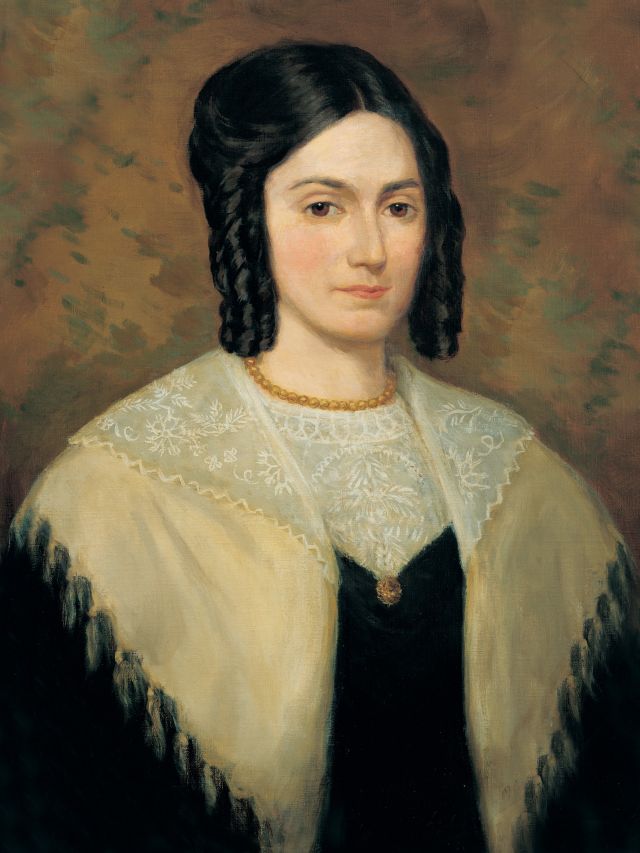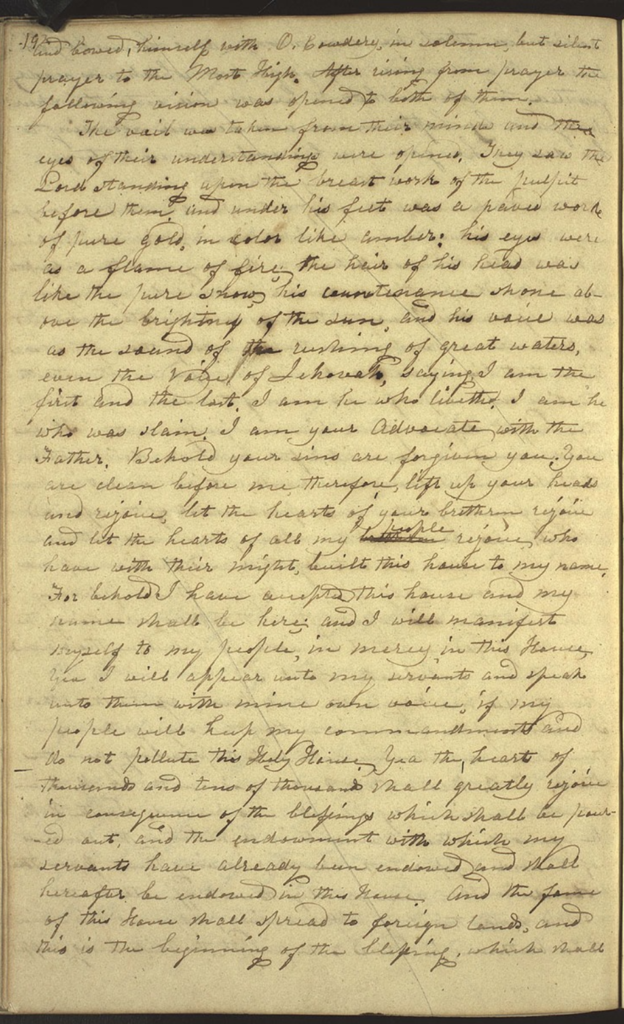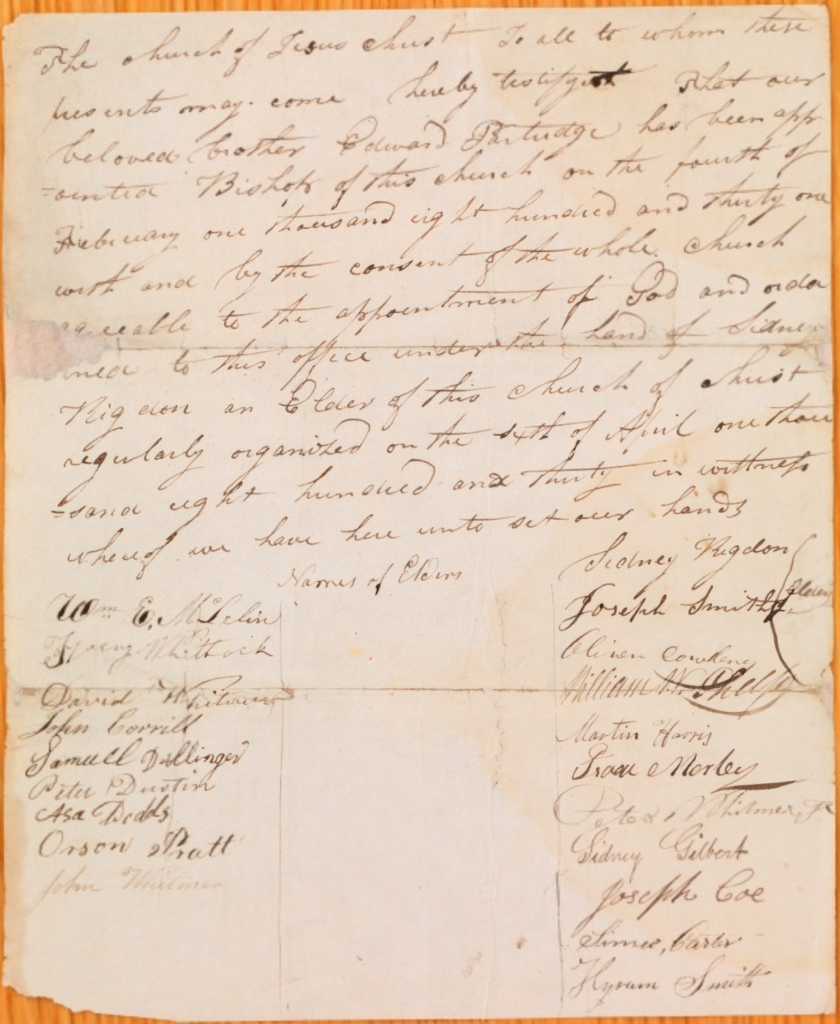Section 23
Once the Church of Jesus Christ was organized, Joseph’s brothers Hyrum and Samuel, their father, together with Oliver Cowdery and Joseph Knight, were “anxious to know of the Lord what might be their respective duties, in relation to this work.” Joseph’s history says, “I enquired of the Lord and received for them the following.”[1]
In section 23, the Lord speaks to each of these men in turn, offering blessings and warnings, prophecies and promises. Note especially the conditions on which the prophesied blessings depend.
Oliver Cowdery pridefully withdrew from the church in 1838 and remained out for a decade before returning humbly. During that period he wrote defensively about his importance in the restoration. Afterward Oliver testified meekly of the Book of Mormon and of receiving the priesthood from ministering angels along with Joseph Smith.[2] When Oliver was aware of pride and made his calling known, the Lord opened his heart to preach the truth.
For Hyrum, verse 3 fulfills the Lord’s promise to him in section 11. There the Lord told Hyrum Smith that if he would learn the word of the Lord, then his tongue would be loosed to preach it. Hyrum must have studied the scriptures in the year between the two revelations, since section 23 announces that his tongue is loosed. Hyrum preached powerfully ever after. Joseph’s father and brother Samuel also became effective missionaries and church leaders in response to this revelation.
Joseph Knight had done so much for Joseph—provided money, paper for the Book of Mormon, food, transportation, and moral support. He was most comfortable behind the scenes. What section 23 commanded was more difficult for him: to join the church meant to preach the gospel. Father Knight wrote that he wrestled with the decision to be baptized but finally decided not to. A few weeks later, he and his wife chose to be baptized.
Section 24
Joseph had a rough month between the church’s spirit-filled June conference in Fayette, New York and this July 1830 revelation. He returned to his home in Pennsylvania and then visited the saints in nearby Colesville, New York. Reverend John Sherer, who was losing some of his Presbyterian followers to the restored gospel, stirred prejudice against Joseph. Sherer’s followers interrupted baptismal services and he finally kidnapped Emily Coburn in an attempt to prevent her baptism.
When several who had been baptized, including Emma Smith, were to be confirmed, a constable arrested Joseph “on charge of being a disorderly person; of setting the country in an uproar by preaching the Book of Mormon.” The charges didn’t stick, but as soon as the court acquitted Joseph a constable from the neighboring county arrested him again and hauled him over the county line. All the antagonistic witnesses could offer was hearsay. Newel Knight embarrassed the prosecution with his testimony. Public opinion began to turn in Joseph’s favor. The court again acquitted him as his persecutors threatened to tar and feather him. The formerly hostile constable helped Joseph escape to Emma’s sister’s house, where Emma anxiously waited.
She and Joseph finally returned to their Harmony, Pennsylvania home the next day. He returned to Colesville a few days later with Oliver Cowdery to confirm the new converts, only to be chased all night by the same enemies. “Shortly after we returned home,” Joseph wrote, referring to Sections 24 and 25, “we received the following commandments.”[1]
Section 24 is one of several revelations in which the Lord meets Joseph where he is.
Though he has become larger than life to many, Joseph, like Nephi, thought of himself as a sinner who needed redemption through the atonement of Jesus Christ. In Section 24 the Lord acknowledges both Joseph’s accomplishments and his sins, commanding him to sin no more.
Section 24 addresses Joseph’s concern about finances and how to provide for his family. It does not promise wealth, only that Joseph will have sufficient if he attends to his calling: “thou shalt devote all thy service in Zion.” Because Joseph devotes all his service to the saints, the saints are responsible to see that his family’s needs are met.
Oliver too is encouraged to give his all to the kingdom. Perhaps hoping to escape further persecution, both of the church’s presiding elders are promised plenty of afflictions to endure. The Lord does, however, promise to smite anyone who uses violence against them. Those who use the law to persecute the prophet will find themselves cursed by the law. In sum, the two young apostles are now in the full time service of the Lord. He promises to look after them as they trust him and take up his cross and follow him, devoting their lives wholly to his service.
Section 25

In the summer of 1830, Emma Hale Smith was baptized near Colesville, New York as a group of angry neighbors objected. Before she could be confirmed, the raging crowd drove her and other saints into the Knight family’s home for refuge. Then a constable arrested Joseph for preaching the Book of Mormon. Emma awaited the outcome for a few days at her sister’s home, feeling that her “very heart strings would be broken with grief” as she witnessed her neighbors’ hostility toward her husband.[1]
It wasn’t only Emma’s confirmation that had been interrupted. Choosing to marry Joseph had disrupted the trajectory of Emma’s life. As with so many women who came of age in her time and place, Emma was raised to aspire to middle class respectability. Given her tumultuous married life thus far, she couldn’t help but be concerned about her financial future.
Then in section 24 the Lord essentially guaranteed Joseph and Emma a modest living if the saints would support them. They would have enough to enable him to devote his life to the church, but no guarantee of things of this world. All section 24 seemed to assure Emma was a life of hardship with a husband who belonged to the church.
To that point, the Lord had only spoken to the men of the Church, though, like Emma, the women of the Church—Lucy Mack Smith, Mary Whitmer, Polly Knight, and many others—were just as much its backbone and as vital as a heartbeat.
Then the Lord let Emma know that he could see through her eyes and gave her an opportunity to see through his.
The earliest manuscript of section 25 begins more intimately than the more formal, published version. “Emma my daughter in Zion,” the Lord says, “A Revelation I give unto you concerning my will Behold thy sins are for given thee & thou art an Elect Lady whom I have called.”[2] He reveals His will to this highly favored daughter, promising to preserve her life and her place in Zion if she will be faithful and virtuous. This was no hollow promise to a woman living in a time of high maternal mortality rates. Emma nearly died after giving birth to her first child.
The Lord’s command that Emma “murmur not because of the things which thou hast not seen,” is often assumed to refer to the Book of Mormon plates but there is no basis for that conclusion. There were many things Emma did not see, and the Book of Mormon plates may not have been among them.
The revelation gives Emma a calling, or several actually. “The office of thy calling shall be for a comfort unto my servant, Joseph Smith, Jun., thy husband . . . ” As this sentence suggests and one might expect, at times Emma felt as if she was in a tug-o-war with the Lord over Joseph. Still, she excelled at meekly comforting and consoling him.
Emma, the Lord said, was called to be Joseph’s partner, his confidant, his strength; and he hers. The Lord commands her to go with Joseph when he goes, scribe for him when he has no other scribe (freeing Oliver Cowdery for other duties), and be ordained to expound scripture and exhort the church by the Spirit. Joseph is to lay hands on Emma to bestow the Holy Ghost, and she shall spend her time scribing and learning much in the process. She need not fear. Joseph will support her in this calling. That is his calling, and by doing it Joseph reveals whatever the Lord wills, according to the saints’ faith.
Emma can see where all this is leading. “Lay aside the things of this world and seek for the things of a better,” the Lord invites. Lay aside your telestial world aspirations and feed your celestial ones.
The Lord also called Emma to select sacred hymns for the church.
He delights in the heartfelt song. Thus Emma may be encouraged and rejoice and cleave to her covenants. Continue to be meek, the Lord commands her, and beware of pride. “Let thy soul delight in thy husband, and the glory which shall come upon him.” A crown of righteousness awaits Emma if she keeps these commandments continually.
Emma was confirmed and compiled the church’s first two hymnals in response to section 25, but the revelation is significant far beyond those accomplishments. It addresses Emma’s deepest fears and fondest hopes. This is the only revelation in the Doctrine and Covenants addressed to a woman. It shows that the Lord knew his daughter. He knew she was meek but could be proud. He knew that part of her wanted to complain because she had not seen some of the marvelous things others had seen. He knew she could be tempted by the things of this world. He invited her to sacrifice them for infinitely more. He knew before she knew that she was capable of scribing for Joseph, of learning much, and of teaching the saints by the power of the Holy Ghost. He knew that these callings would cause Emma anxiety. He assured her that Joseph would support her. He knew that she needed Joseph. He knew that Joseph needed her, and he called her to comfort and sustain Joseph.
Section 25 oriented Emma’s life.
Expecting twins, she forsook her unbelieving parents to obey its command to go with Joseph to Ohio, and she never saw them afterwards. A decade later Emma was elected by her sisters to preside over the Relief Society, which Joseph validated. He read the revelation to the sisters from the Doctrine and Covenants and said that Emma had been “orddain’d at the time, the Revelation was given to expound the scriptures to all; and to teach the female part of the community.” She was and sustained in her calling by her husband and her sister saints.[3]
A few weeks later Joseph was evading arrest on false charges. It was a depressing time of his life. There was tension between him and Emma over plural marriage, straining their relationship. Emma went to great lengths to visit Joseph in that situation. His journal entry says, “again she is here, even in the seventh trouble, undaunted, firm and unwavering, unchangeable, affectionate Emma.”[4]
In September 1843, Joseph sealed on Emma’s head the “crown of righteousness” the Lord promised in section 25. Then, just days before his death in 1844, Joseph invited Emma to write her own blessing. She thought of Section 25 and penned her hopes that she would be able to obey its commands and receive its promised blessings.[5] She clung to her covenants through Abrahamic tests. Emma understandably could have, and perhaps sometimes did, consider herself in competition with the Lord and others for Joseph’s time and attention. Section 25 assured her that however that might be, she was the Lord’s highly favored daughter, that he expected more of her than she may have thought she could give, and that he would finally give her all she ultimately wanted.
Section 26
Joseph and the saints in southern New York endured a blast of persecution in the summer of 1830. The Knight family in Colesville were understandably anxious. Back home in the nearby but comparatively peaceful setting of Harmony, Pennsylvania, Joseph received a series of revelations including section 26. The Lord gave it to Joseph, Oliver Cowdery, and John Whitmer to teach them what to do until the conference scheduled for September in Fayette, New York.
The revelation says simply that Joseph and his brethren are to devote their time to scripture study, preaching, confirming the saints in southern New York, and farming as needed until time for conference later in the summer. There he will direct them further.
The most significant, if understated, aspect of the revelation is the line, “all things shall be done by common consent in the church, by much prayer and faith.” (D&C 26:2) The Lord had revealed this principle earlier, but that revelation is not canonized, so this is the first mention of common consent in the Doctrine and Covenants. Joseph’s manuscript history says that before the Church was organized, the Lord commanded he and Oliver to ordain each other elders in the Church of Jesus Christ, and then ordain others, but only after they could gather all who had been baptized to get “their sanction,” and be “accepted by them as their teachers.”[1]
At that meeting the members of the church, the women and men accepted Joseph and Oliver as their leaders by a unanimous vote.[2] Though the word vote is used, common consent differs from a democratic election. In common consent, Church leaders put forward a proposal and ask for consent and dissent. Though consent is common, it is not taken for granted and dissent is to be respected. The presiding authority meets with a dissenting member to learn why they dissented and acts accordingly. In an unusual turn of events, Joseph Smith dissented in October 1843 at the proposal that Sidney Rigdon be sustained as his counselor in the First Presidency. Joseph’s dissent was overruled by the Church after a lengthy discussion.[3]
Newel Knight said section 26 provided “great consolation to the little band of Brethren and Sisters at Colesville after having been abandoned from time to time by the servants of God in consequence of the wicked who were constantly seeking to destroy the work of God from the earth. It showed us that the Lord took cognizance of us and also that he knew the acts of the wicked. So we resolved to continue steadfast in the faith and were diligent in our prayers and assembling ourselves together, waiting with patience until we should have the pleasure of again seeing Brother Joseph and others of the Servants of the Lord who had become dear to us by the ties of the gospel, and of being confirmed members of the Church of Jesus Christ by the laying on of hands of the Apostles.”[4]
Section 23 notes
[1] “History, 1838–1856, volume A-1 [23 December 1805–30 August 1834],” p. 38, The Joseph Smith Papers, accessed July 23, 2020, https://www.josephsmithpapers.org/paper-summary/history-1838-1856-volume-a-1-23-december-1805-30-august-1834/44.
[2] Steven C. Harper, “Oliver Cowdery as Second Witness of Priesthood Restoration,” in Days Never to Be Forgotten: Oliver Cowdery, ed. Alexander L. Baugh (Provo, UT: Religious Studies Center, Brigham Young University, 2009), 73–89.
Section 24 notes
[1] “History, 1838–1856, volume A-1 [23 December 1805–30 August 1834],” p. 48, The Joseph Smith Papers, accessed July 23, 2020, https://www.josephsmithpapers.org/paper-summary/history-1838-1856-volume-a-1-23-december-1805-30-august-1834/54.
Section 25 notes
[1] “Some of the Remarks of John S. Reed, Esq., as Delivered before the State Convention,” Times and Seasons 5 (I June 1844): 549-52. Joseph Smith, Manuscript History 1838-1856, May 17, 1844, Book F-1, page. 48.
[2] “Revelation, July 1830–C [D&C 25],” p. 34, The Joseph Smith Papers, accessed July 23, 2020, https://www.josephsmithpapers.org/paper-summary/revelation-july-1830-c-dc-25/1.
[3] “Nauvoo Relief Society Minute Book,” p. 8, The Joseph Smith Papers, accessed July 23, 2020, https://www.josephsmithpapers.org/paper-summary/nauvoo-relief-society-minute-book/5.
[4] Journal, December 1841–December 1842,” p. 164, The Joseph Smith Papers, accessed July 23, 2020, https://www.josephsmithpapers.org/paper-summary/journal-december-1841-december-1842/41. See Job 5:19
[5] Carol Cornwall Madsen, “The ‘Elect Lady’ Revelation: The Historical and Doctrinal Context of Doctrine & Covenants 25,” in The HeavensAre Open (Salt Lake City: Deseret, 1993): 211-18.
Section 26 notes
[1] “History, circa June–October 1839 [Draft 1],” p. [8], The Joseph Smith Papers, accessed July 23, 2020, https://www.josephsmithpapers.org/paper-summary/history-circa-june-october-1839-draft-1/8.
[2] “History, circa June–October 1839 [Draft 1],” p. [9], The Joseph Smith Papers, accessed July 23, 2020, https://www.josephsmithpapers.org/paper-summary/history-circa-june-october-1839-draft-1/9.
[3] “History, 1838–1856, volume E-1 [1 July 1843–30 April 1844],” p. 1747-1749, The Joseph Smith Papers, accessed July 23, 2020, https://www.josephsmithpapers.org/paper-summary/history-1838-1856-volume-e-1-1-july-1843-30-april-1844/119.
[4] Newel Knight, Autobiography and Journal, 1846, Church History Library, Salt Lake City.



